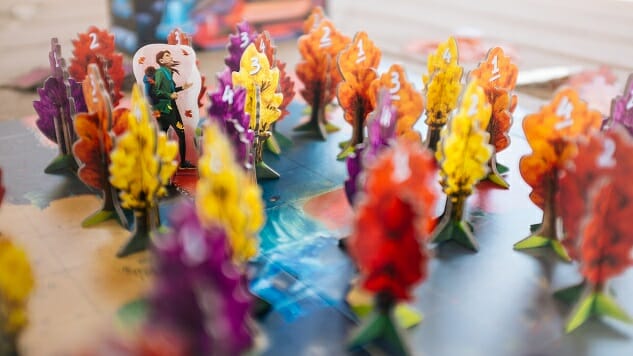Bosk Is a Beautiful Board Game, But a Slog to Play

Bosk is the latest game from one of the co-designers of Sagrada, among my favorite games of 2017 (and recently expanded with three new titles), taking on a theme of growing trees and falling leaves where players aim for area control in two distinct phases. It’s a beautiful game with one of the best storage solutions I’ve come across, but the game play itself just doesn’t work for me; it plays slowly, and planning for the second and more important phase of the game can be too inconsequential for a strategy game.
In Bosk, two to four players each get a specific color of tree for the game, taking eight trees (3D cardboard pieces, as in Photosynthesis), 42 handsome wooden leaf tokens, eight cardboard leaf tokens, and one squirrel. The game’s phases correspond to the four seasons of the year, so you plant trees, then score them, then scatter leaves according to the shifting winds, and score those in a different way.
The spring planting phase is fairly simple. Players will go around the table and place all eight of their trees, which are numbered from one to four (two of each), on the intersections of gridlines around the board, with different board sizes for each number of players. After every player has placed all eight of their trees, the gridlines are scored in both directions. Add up the face values of each player’s trees on each gridline, awarding two points to the player who had the most total value on a line and one point to the player with the second-most. If you’re alone on a gridline, you get all three points. Thus the scoring for this first part, which counts as summer—tourists come and walk through the woods, along the gridlines, although in typical Keith-overthinking-the-theme fashion I kept picturing the hikers colliding with the trees—is modest, and it’s unlikely any player will rack up much of a lead.
The meat of the game comes in the fall, when players will scatter leaves from their eight trees to try to control squares in the eight distinct areas of the board. The player with the lowest score after summer gets to choose where the wind direction board sits for the remainder of the game; the wind will rotate through all four directions twice as players get to scatter leaves from all eight of their trees. On your turn, you pick one of your trees and one of your cardboard leaf tokens, which show numbers from two through eight. You then scatter that many leaves downwind from the tree you’ve chosen, with the goal of covering more squares in each area of the board than your opponents. Placing a wooden leaf on any empty square is free, but you can also place your leaf on top of someone else’s leaf token, paying (discarding) one leaf from your hand for each leaf in the pile you’re covering. That means the higher-value cardboard leaves are more useful later in the autumn phase, because they give you the power to cover other players’ piles and seize control of specific squares, creating a lot of back-and-forth battles for control of certain areas.
The squirrel also appears in the autumn as a sort of trump card. On one of your eight turns, you’ll still pick a tree, but this time you won’t scatter leaves, instead playing the squirrel somewhere downwind of your tree, covering any pile of any size for no cost with your squirrel. The squirrel can’t be topped, literally or figuratively, so you gain control of that square permanently. It’s powerful, but you also spend one of your eight autumn turns to place the squirrel (and no leaves).
-

-

-

-

-

-

-

-

-

-

-

-

-

-

-

-

-

-

-

-

-

-

-

-

-

-

-

-

-

-

-

-

-

-

-

-

-

-

-

-









































